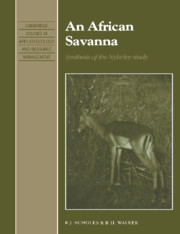Book contents
- Frontmatter
- Contents
- Preface
- I Nylsvley in an African savanna context
- 1 African savannas: an overview
- 2 The people of Nylsvley
- 3 The climate at Nylsvley
- 4 Geology, landform and soils
- 5 The Nylsvley biota
- II The key determinants: water, nutrients, fire and herbivory
- III The carbon cycle
- IV Community and landscape pattern and change
- Part V Lessons from Nylsvley
- Bibliography
- Index
2 - The people of Nylsvley
Published online by Cambridge University Press: 06 October 2009
- Frontmatter
- Contents
- Preface
- I Nylsvley in an African savanna context
- 1 African savannas: an overview
- 2 The people of Nylsvley
- 3 The climate at Nylsvley
- 4 Geology, landform and soils
- 5 The Nylsvley biota
- II The key determinants: water, nutrients, fire and herbivory
- III The carbon cycle
- IV Community and landscape pattern and change
- Part V Lessons from Nylsvley
- Bibliography
- Index
Summary
There is a tendency among ecologists, especially if they habitually work in conserved areas, to regard people and their effect on ecosystems as an unnatural disturbance. In practice, the distinction between ‘natural’ and ‘man-made’ ecosystems is blurred and frequently arbitrary. This is particularly true of African ecosystems, which have an ancient association with humans, but only a recent exposure to Western technology. This chapter describes the successive inhabitants of the Nylsvley region, and the impact which they have had on the savannas there.
The first white settlers believed that they had come into a pristine landscape, despite the fact that it was populated to varying degrees, and had been for millennia. Their attitudes persist in a nostalgic perception by the South African public of the ‘pre-colonial period’ as a time of undisturbed natural harmony and equilibrium. In fact, disturbances play a critical part in maintaining the structure of the vegetation. In the context of savannas, many of these disturbances are partly or wholly of human origin: burning, wood-collecting, grazing, and cultivation to name a few. The historical land-use pattern is important in that it is one of the determinants of the ecosystem as we see it now. The ‘wilderness’ landscapes of Africa are in part a consequence of centuries of human influence.
Nylsvley offers, within a small area, all the ingredients for successful human habitation: water, grazing, arable soils, fuelwood and rocky hills for refuge in times of unrest.
- Type
- Chapter
- Information
- An African SavannaSynthesis of the Nylsvley Study, pp. 17 - 23Publisher: Cambridge University PressPrint publication year: 1993



